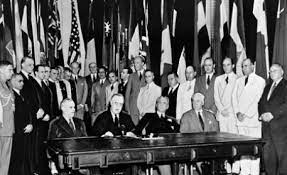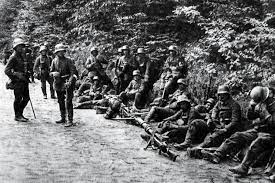First barrel ride down Niagara Falls
On October 24, 1901, a 63-year-old schoolteacher named Annie Edson Taylor becomes the first person to successfully take the plunge over Niagara Falls in a barrel.
After her husband died in the Civil War, the New York-born Taylor moved all over the U. S. before settling in Bay City, Michigan, around 1898. In July 1901, while reading an article about the Pan-American Exposition in Buffalo, she learned of the growing popularity of two enormous waterfalls located on the border of upstate New York and Canada. Strapped for cash and seeking fame, Taylor came up with the perfect attention-getting stunt: She would go over Niagara Falls in a barrel.
Taylor was not the first person to attempt the plunge over the famous falls. In October 1829, Sam Patch, known as the Yankee Leaper, survived jumping down the 175-foot Horseshoe Falls of the Niagara River, on the Canadian side of the border, without anything on him. More than 70 years later, Taylor chose to take the ride on her birthday, October 24. (She claimed she was in her 40s, but genealogical records later showed she was 63.) With the help of two assistants, Taylor strapped herself into a leather harness inside a custom wooden pickle barrel five feet high and three feet in diameter. With cushions lining the barrel to break her fall, Taylor was towed by a small boat into the middle of the fast-flowing Niagara River and cut loose.
Knocked violently from side to side by the rapids and then propelled over the edge of Horseshoe Falls, Taylor reached the shore alive, if a bit battered, around 20 minutes after her journey began. After a brief flurry of photo-ops and speaking engagements, Taylor’s fame cooled, and she was unable to make the fortune for which she had hoped. She did, however, inspire a number of copy-cat daredevils. Between 1901 and 1995, 15 people went over the falls; 10 of them survived. Among those who died were Jesse Sharp, who took the plunge in a kayak in 1990, and Robert Overcracker, who used a jet ski in 1995. No matter the method, going over Niagara Falls is illegal, and survivors face charges and stiff fines on either side of the border.
GERMANY
1648
Thirty Years' War ends
The Treaty of Westphalia is signed, ending the Thirty Years' War and radically shifting the balance of power in Europe. The Thirty Years' War, a series of wars fought by European nations for various reasons, ignited in 1618 over an attempt by the king of Bohemia (the future Holy Roman emperor Ferdinand II) to impose Catholicism throughout his domains. Protestant nobles rebelled, and by the 1630s most of continental Europe was at war.
21ST CENTURY
2003
The Concorde makes its final flight
The supersonic Concorde jet makes its last commercial passenger flight, traveling at twice the speed of sound from New York City’s John F. Kennedy International Airport to London’s Heathrow Airport on October 24, 2003.
ART, LITERATURE, AND FILM HISTORY
1969
Richard Burton buys Elizabeth Taylor a diamond
Movie star Richard Burton dazzles wife Elizabeth Taylor—and their legions of fans—when he buys her a 69-carat Cartier diamond ring costing $1.5 million. It was just another chapter in a tempestuous marriage that began on the Ides of March and continued thereafter in the public eye.
WORLD WAR II
1945
The United Nations is born
On October 24, 1945, the United Nations Charter, which was adopted and signed on June 26, 1945, is now effective and ready to be enforced. The United Nations was born of perceived necessity, as a means of better arbitrating international conflict and negotiating peace than was provided for by the old League of Nations. The growing Second World War became the real impetus for the United States, Britain, and the Soviet Union to begin formulating the original U.N. Declaration, signed by 26 nations in January 1942, as a formal act of opposition to Germany, Italy, and Japan, the Axis Powers.
VIETNAM WAR
1954
President Eisenhower pledges support to South Vietnam
President Eisenhower pledges support to Diem’s government and military forces. Eisenhower wrote to South Vietnamese President Ngo Dinh Diem and promised direct assistance to his government. Eisenhower made it clear to Diem that U.S. aid to his government during Vietnam’s “hour of trial” was contingent upon his assurances of the “standards of performance [he] would be able to maintain in the event such aid were supplied.” Eisenhower called for land reform and a reduction of government corruption. Diem agreed to the “needed reforms” stipulated as a precondition for receiving aid, but he never actually followed through on his promises. Ultimately his refusal to make any substantial changes to meet the needs of the people led to extreme civil unrest and eventually a coup by dissident South Vietnamese generals in which Diem and his brother were murdered.
U.S. PRESIDENTS
1951
President Truman declares war with Germany is officially over
On October 24, 1951, President Harry Truman finally proclaims that the nation’s war with Germany, begun in 1941, is officially over. Fighting had ended in the spring of 1945. Most Americans assumed that the war with Germany had ended with the cessation of hostilities six years earlier. In fact, a treaty with Germany had not been signed. Complicating the treaty process was the status of territory within what was formerly the German state. Following the Second World War, the major Western powers (U.S., Britain and France) and the Soviets agreed to divide the country, including the capital city of Berlin, into democratic and communist-controlled sectors. Both East and West Berlin ended up within the Soviet-controlled territory of East Germany and the capital became the epicenter of increasing tensions between the West and Soviet Russia. Each side claimed the other had violated post-war treaties regarding their respective spheres of influence in post-war Europe.
WESTWARD EXPANSION
1861
Western Union completes the first transcontinental telegraph line
On October 24, 1861, workers of the Western Union Telegraph Company link the eastern and western telegraph networks of the nation at Salt Lake City, Utah, completing a transcontinental line that for the first time allows instantaneous communication between Washington, D.C., and San Francisco. Stephen J. Field, chief justice of California, sent the first transcontinental telegram to President Abraham Lincoln, predicting that the new communication link would help ensure the loyalty of the western states to the Union during the Civil War.
ART, LITERATURE, AND FILM HISTORY
1962
James Brown records breakthrough “Live at the Apollo” album
James Brown began his professional career at a time when rock and roll was opening new opportunities for Black artists to connect with white audiences. But the path he took to fame did not pass through Top 40 radio or through The Ed Sullivan Show and American Bandstand.
ART, LITERATURE, AND FILM HISTORY
1969
“Butch Cassidy and the Sundance Kid” opens in wide release
On October 24, 1969, Butch Cassidy and the Sundance Kid, starring Paul Newman and Robert Redford as a team of bank robbers in the Old West, opens in theaters around the United States. The film was a commercial and critical success, receiving seven Oscar nominations (including Best Picture and Best Director) and winning in the categories of Best Screenplay (William Goldman), Best Song (Burt Bacharach’s “Raindrops Keep Falling on My Head”), Best Score and Best Cinematography.
CRIME
1997
Marv Albert faces sentencing in sexual assault case
Circuit Court Judge Benjamin Kendrick announces that he will dismiss the sexual assault case filed against Marv Albert by 42-year-old Vanessa Perhach if the sportscaster agrees to get counseling and stays out of trouble for a year.
INVENTIONS & SCIENCE
1931
George Washington Bridge is dedicated
On October 24, 1931, eight months ahead of schedule, New York governor Franklin D. Roosevelt dedicates the George Washington Bridge over the Hudson River. The 4,760-foot–long suspension bridge, the longest in the world at the time, connected Fort Lee, New Jersey with Washington Heights in New York City. “This will be a highly successful enterprise,” FDR told the assembled crowd at the ceremony. “The great prosperity of the Holland Tunnel and the financial success of other bridges recently opened in this region have proven that not even the hardest times can lessen the tremendous volume of trade and traffic in the greatest of port districts.”
WORLD WAR I
1921
Unknown Soldier is selected
On October 24, 1921, in the French town of Chalons-sur-Marne, an American sergeant selects the body of the first “Unknown Soldier” to be honored among the approximately 77,000 United States servicemen killed on the Western Front during World War I.
WORLD WAR I
1917
Battle of Caporetto
On October 24, 1917, a combined German and Austro-Hungarian force scores one of the most crushing victories of World War I, decimating the Italian line along the northern stretch of the Isonzo River in the Battle of Caporetto, also known as the Twelfth Battle of the Isonzo, or or the Battle of Karfreit (to the Germans).














Comments
Post a Comment